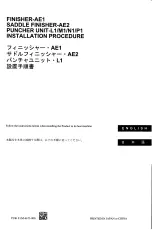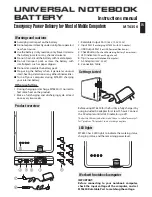
–
Male connector connection: pin assignment
–
Cable: core color
Image: B
Only apply voltage/switch on the power supply (V
S
> 0 V) once all electrical connec‐
tions have been completed. The green LED indicator lights up on the sensor.
Explanations of the connection diagram (Graphic B):
Switching outputs Q and /Q (according to Graphic B):
WTV4-3Exxxx and WTV4-3Fxxxx
D: dark-switching, output (Q) switches off when an object is present in the sensing
range.
WTV4-3Px1xx and WTV4-3Nx1xx
L: light switching, output (Q) switches when an object is present in the sensing ran‐
ge.
WTV4-3P1141 and WTV4-3N1141
WTV4-3Px241 and WTV4-3Nx241
ANT: complementary outputs Q and Q/
3
Sensor with potentiometer:
The sensing range is adjusted with the potentiometer (type: 5-Gang). Clockwise ro‐
tation: sensing range increased; counterclockwise rotation: sensing range reduced.
Standard detection of non-transparent objects:
Ensure that the transition range between the sensing range (x) and the background
(y) is > 2.5 mm (cf. E). Sensor has no significant S/W shift.
Detection of transparent objects:
K = tilt angle
Optimum detection of transparent objects aligned parallel to the sensor, at a dis‐
tance of 15 mm to 25 mm. It is recommended to set the scanning range to twice
the object distance (cf. F & G). Recommended transition range between the scan‐
ning range (x) and the background (y) is at least 35 mm (cf. G). The greater the dis‐
tance between the scanning range and the background, the better the detection
reliability.
Standard setting for non-transparent objects:
Position the object and direct the light spot onto it. Red emitted light spot can be
detected on the object. Turn the adjustment to the minimum scanning range. Then
increase the scanning range until the yellow LED indicator lights up. Recommen‐
ded: If high contrast or poorly remitting objects are detected, increase the scanning
range by adding a safety supplement of 10% of the scanning range (cf. F).
Standard setting for transparent objects:
Keep diffuse bright object (e.g. cardboard insert for packaging) in the beam path at
twice the sensing range. Set sensor according to "Setting for non-transparent ob‐
jects". Keep transparent object in the beam path. The yellow indicator LED lights
up. If the beam path fails to behave in accordance with Graphic C/D and G, check
application conditions. See section Fault diagnosis.
The sensor is adjusted and ready for operation. Refer to Graphics C/D and G to
check the function. If the switching output fails to behave in accordance with Gra‐
phic C/D, check application conditions. See section Fault diagnosis.
3
COMMISSIONING
2
8011167.
126R
| SICK
Subject to change without notice




































